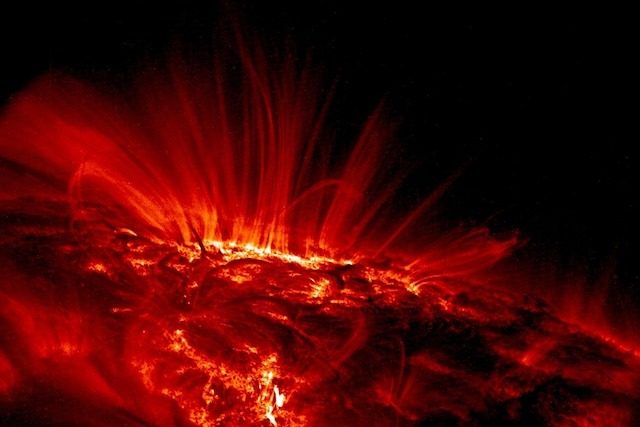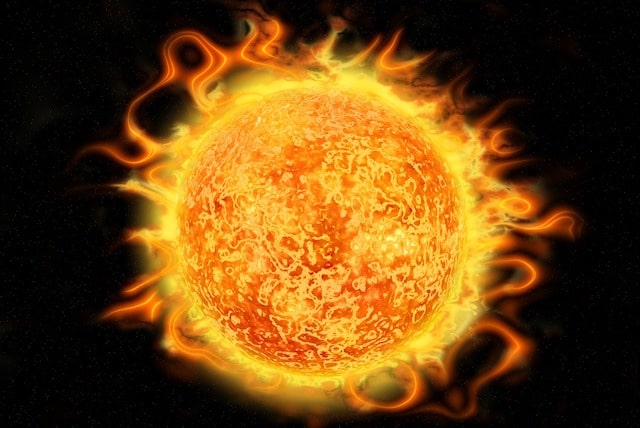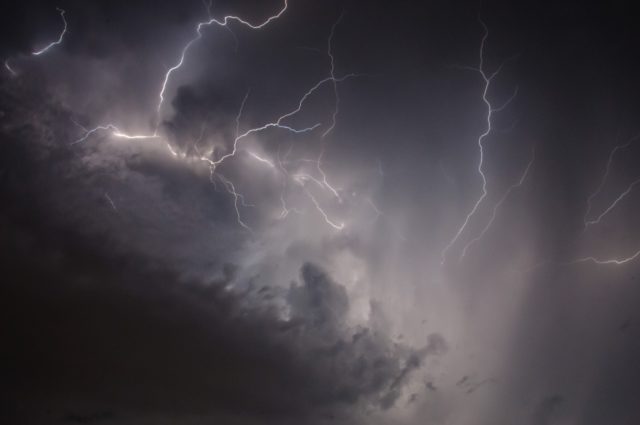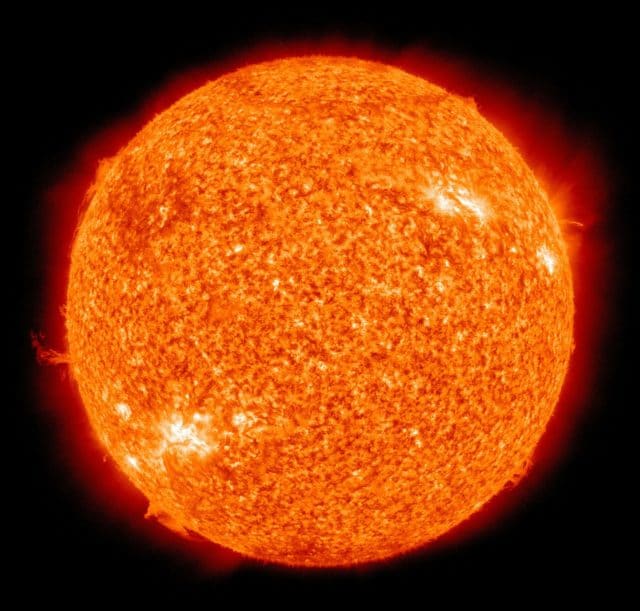Over 99% of the mass in our entire solar system exists just in the sun. It’s over a hundred times wider than Earth but more than 330,000 times as massive. And all that mass is hydrogen or helium. The entire thing has been burning for 4.6 billion years and it still has a good 5 billion years to go before all the fuel is burned off. All things being equal, it’s an amazing thing. There’s still a lot we don’t know about our star, but the things that we do now, especially about solar storms, are pretty terrifying.
10. Solar Flares Could Shut the World Down

Solar flares are nothing new, and occur very frequently on the surface of the sun. Visually they would just look like a bright spot on the surface of an already very bright object. They’re caused by an acceleration of particles inside the sun’s body that expel rapidly. Normally not a cause for alarm, except they exist in degrees of magnitude, and a big solar flare could have big repercussions.
It’s been predicted that a massive enough solar flare, if it was released in the direction of the Earth, could have enough electromagnetic energy to essentially shut down our planet. GPS satellites, telecommunications, the internet, basically everything we take for granted today would be clicked off.
It’s all speculative, but there is the possibility. And the full scope of things affected is staggering. It’s not just communication systems, it’s things like power grids that keep nuclear reactors from overheating. That kind of scary stuff. Even in just dollars and cents it’s been predicted that something like this would cost the world about $10 trillion to fix. The upside? It’s been predicted that there’s about a 12% chance of it happening within the next decade.
9. Coronal Mass Ejections are Enormous

Coronal mass ejection is not the same as a solar flare, and generally follows on the heels of a solar flare. It’s a massive release of plasma from the sun’s corona, and is characterized by an intense magnetic field. And they are not small by any means.
A mass coronal ejection can contain about one million tons of solar material as it explodes outward. They can travel at a speed of 4,473,873 miles per hour and have a radial size of 23 million miles. They can appear even larger than the sun itself.
8. Solar Proton Events Dose Airplanes with Radiation

A lot of radiation gets released during a solar storm and if it happens to vent in the direction of Earth our planet gets bathed in it. This isn’t usually a problem, though, as our atmosphere keeps us safe from that sort of thing. Solar flares have been happening since the sun first existed so it’s nothing to get particularly worked up about when you’re standing on the ground. There may be a problem when you’re not standing on the ground, though.
Research has shown that astronauts in particular, and even those on airplanes, are at greater risk for radiation exposure when solar events occur. Passengers and the crew on a plane flying at 40,000 feet during a solar event, based on one recorded in 2017, would have received between 90 and 110 microsieverts of radiation. Your average X-ray will give you 100 microsieverts.
That one day’s worth of exposure isn’t so terrible, but consider how often flight attendants and pilots are in the air. It’s estimated that aircraft crew already receive three times the normal dose of background radiation in a given year. During solar events, that exposure skyrockets. Over a lifetime of working in the air, you have the potential to have sucked up quite a number of X-rays’ worth of radiation.
7. They’re Expensive

To fully appreciate the effects of even a mild solar storm we don’t have to go too far into the past. Just 30 years ago, on March 13, 1989 a solar storm caused a massive blackout that shut down a large part of the province of Quebec in Canada.
The burst of plasma from the sun caused an aurora that could be seen as far south as Florida and Cuba. Millions of Quebec residents were without power for about 12 hours. The cost was estimated at $13.2 million. Estimates for future costs of larger storms are staggering. Some predictions have these storms costing us as much as $40 billion. That’s not in total, that’s per day.
6. They Cause Auroras

Arguably the most unusual side effects of solar storms is the visual effects on our atmosphere. People in the far north are used to the Aurora Borealis, what most people know as the Northern Lights, but they are generally confined to that geographical region. Solar storms bring the north to every region of the world.
Various solar storms have caused the lights to appear over places such as New Zealand, Boston, Cuba, western Africa and elsewhere. Even though the northern lights are harmless, and quite spectacular to behold, showing up unexpectedly in different parts of the world must definitely be jarring to those who live there, especially if they hadn’t heard the news.
5. One Shocked Telegraph Operators

Sometimes known as the Carrington Event, the solar storm of 1859 is the most powerful storm we have recorded. It’s hard to get a complete picture of how intense this event was given the limitations of technology at the time, but accounts of what did happen are almost unbelievable. If they hadn’t come from all over the world, they might very well be unbelievable.
World communications at the time were limited to telegraph machines, and those machines took some serious damage when the storm hit. There are reports that telegraph poles were shooting sparks and operators were experiencing electric shocks through their telegraphs all across the planet. That means the storm was so powerful it actually created an electrical charge essentially out of thin air, which reminds us…
4. They Electrify the Air

To fully appreciate the scope of the Carrington Event and how it affected the world, there is one story that puts it all into perspective. Obviously if telegraph poles were sparking, and there was an aurora visible as far south as Hawaii and parts of Caribbean, this was a massive solar storm. But it had a secondary effect on the telegraph system that was remarkable.
Because the charge in the air had begun shocking telegraph operators, a number of them disconnected their power supplies in an attempt to stave off the damage. Inexplicably, they were able to continue working regardless. There was so much electricity in the air, the telegraphs were able to work with no ready power supply connected.
While this seems a little baffling on one hand, it’s also very similar to the dream that Nikola Tesla had of creating limitless, wireless power for everyone in the world. It can happen, it just takes an impressive amount of effort.
3. One Billion Hydrogen Bombs

Solar flares are classified by their size and intensity. The smallest flares are known as A-Class. After A-Class is B-Class and then C-Class. Things get shaken up a little bit as M-Class follows, and then the final class is X-Class. You can consider the scale to be something like the Richter scale for earthquakes and the Fujita scale for tornadoes. Each letter in the solar flare scale represents a magnitude of 10 higher than the one before it. So if X-Class solar flares are the most powerful solar flares, what exactly does that mean?
To start, this classification is a little bit deceptive. While X is the largest classification on the scale, there’s still a scale within the range of X. X1 is followed by X2, X3 and so on. In 2003 a solar flare was measured up to X28. Each of these numbers is a magnitude 10 higher than the one before it. And the reason that one measured X28 was because that was as high as the sensor went before it cut out.
Understanding the energy released during these massive flares is not easy because it’s so much greater than anything we can experience here on Earth. An X level solar flare has been compared to hydrogen bombs in terms of energy output. More specifically, an X level solar flare releases the same amount of energy as roughly 1 billion hydrogen bombs. And just to be clear, one hydrogen bomb is roughly 10 times more powerful than the atomic bombs dropped during the Second World War.
2. They Are Insanely Fast

Knowing how quickly a thing happens is important to knowing how you can react to it. That’s why so much effort is put into studying things like earthquakes, tidal waves, and hurricanes. We need to have early warning systems in place so that people have time to prepare. Though less a point of concern, knowing how to prepare for a solar storm could certainly benefit the world. The problem is the speed at which these things happen is all but impossible to prepare for.
While some research has shown that a coronal mass ejection should reach the Earth in about three to four days, that’s not always the case. The coronal mass ejection of 1859 was recorded to have reached the Earth in only 17 hours. The level of damage it caused was tempered by the limited technology on Earth at the time. If something like that were to happen today, 17 hours would provide absolutely no time to prepare for for it.
1. We Don’t Really Understand Them

Perhaps the most terrifying thing we know about solar storms is what we don’t know. Fear of the unknown is, after all, a very prominent theme in life. And when it comes to solar storms, while we do understand a lot of the mechanisms behind certain events, there’s just as much (and more) that science has yet to puzzle out.
How powerful a solar storm can get, when it might happen, what it does to the Earth — all of that is speculative at best. The science of space is a lot of theory in the hopes that observation will be able to back it up. And when things are happening on a universal scale, it means that humans can’t always figure out what’s going on.
That means we really have no way to prepare for a large-scale solar storm because we don’t know how to quantify that. We have ideas of ones that existed in the past, and we can guess what a worse one would be like, but we don’t know if it would be even worse than our worst guess.
Luckily, events like this on a cosmic scale are not entirely common. It’s possible a catastrophic solar storm could happen in our lifetime, but it’s just as possible nothing will happen for another 100 million years.